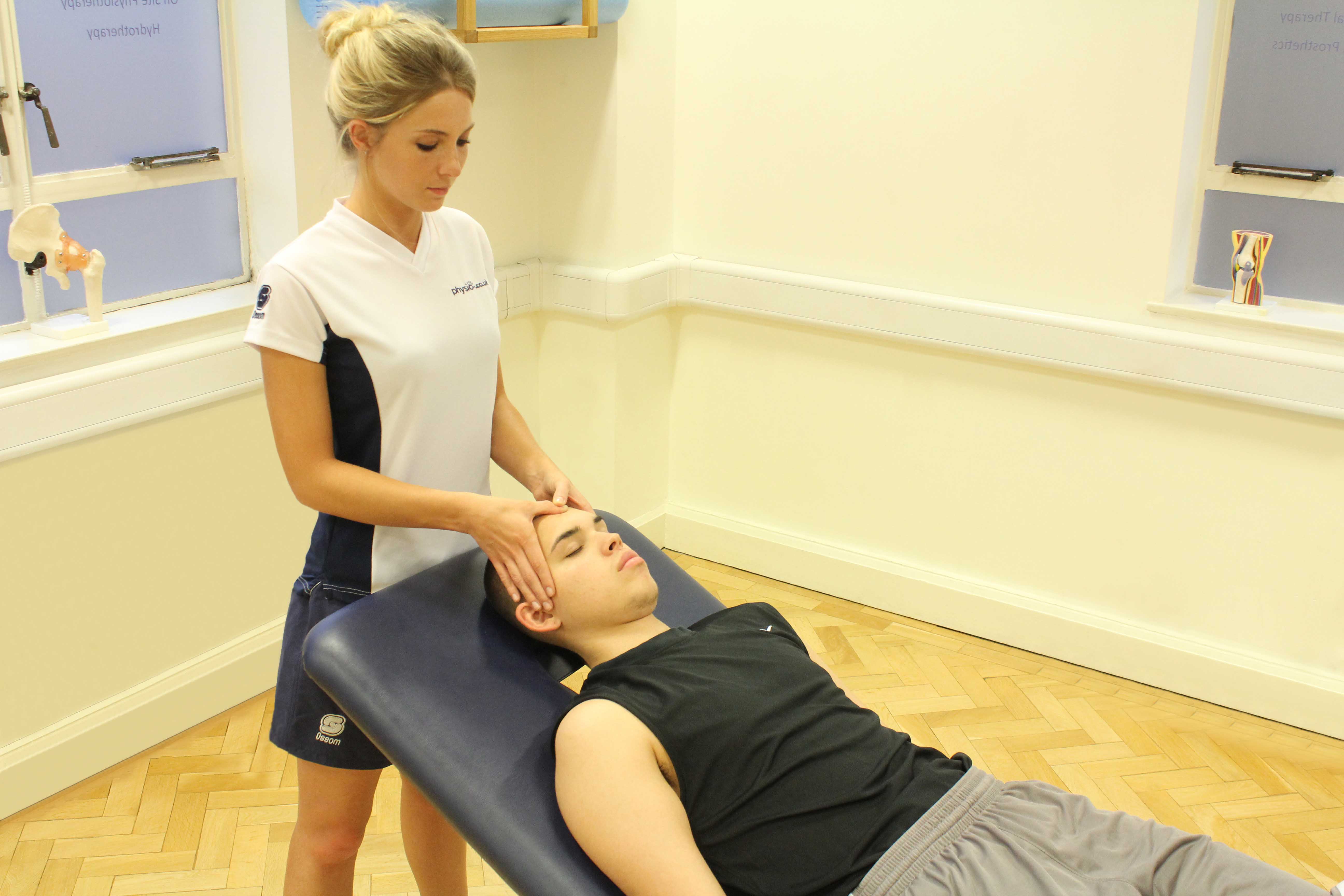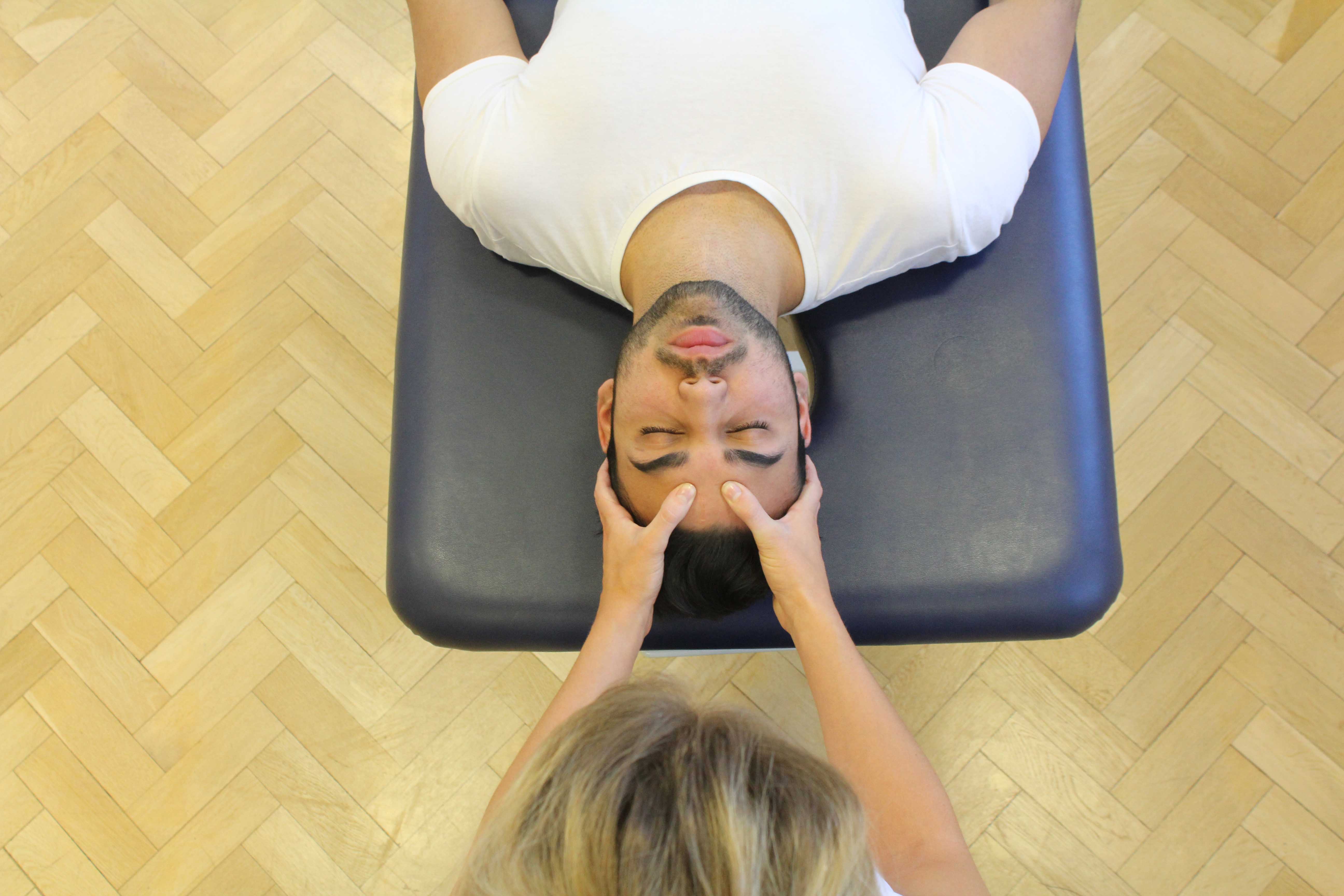A face massage is focused on the muscles and tissues found around the face. A variety of techniques are used to decrease tightness, tension and stress. Massage therapists at Physio.co.uk used a face massage to help decrease pain, increase relaxation and improve circulation.
What techniques are used in a face massage?
Many different techniques are used within a face massage. The most common techniques include:
 Above: soft tissue massage of the facial muscles
Above: soft tissue massage of the facial musclesSkin rolling is a common technique used during a face massage. Skin rolling helps to decrease tightness of muscles and fascia by picking up and rolling skin between the fingers and thumbs. Muscles and fascia often become tight due to inelasticity of muscle fibres. Skin rolling helps to improve blood circulation, increasing the temperature of muscles and fascia. Increasing temperature allows elasticity to increase therefore decreasing tightness.
Trigger pointing can be used during a face massage. Trigger points are located in the middle of muscle fibres and can create a sense of pain if left untreated. During a face massage, pressure is placed on trigger points to help break them down. An ischemic reaction occurs when using the technique trigger pointing. An ischemic reaction is where blood flow is restricted due to pressure being applied. As pressure is released, blood flow is encouraged to the area. An increase in blood flow helps to maintain healthy muscles.
Acupressure is another technique used during a face massage. Acupressure is a technique performed using the fingertips and thumbs. Fingertips and thumbs are used to apply pressure to soft tissue containing pressure and trigger points. When pressure is applied, muscular knots are softened and areas of tightness are reduced. Breaking down muscular knots and reducing tightness decreases pain and encourages relaxation.
Circular strokes can be used during a face massage. Circular strokes are performed using the fingertips or thumbs and can vary in pressure. Circular strokes help to increase circulation to help remove metabolic wastes and exchange them for healthy oxygen and nutrients. Circular strokes can also be used to decrease tightness and tension within the facial area.

When can a face massage help?
A face massage can help in many different ways. Occasions in which a face massage can help include:
 Above: Soft tissue massage of the face
Above: Soft tissue massage of the faceHow does a face massage help relaxation?
A face massage can be used to help encourage relaxation. A face massage can relax a person both physically and mentally.
A face massage aims to increase relaxation by relieving muscle tightness and increasing the levels of positive hormones within the body.
During a face massage, muscle temperature is increased due to friction created between the hands and skin. An increase in temperature allows an increase in the elasticity of muscle tissues. Increased elasticity, increases the range of movement of muscles and therefore decreases tightness. Decreasing tightness allows the muscle to relax and decreases pain.
Psychologically, a face massage relaxes a person by increasing positive hormones around the body. Positive hormones include dopamine, serotonin and endorphins. An increase in positive hormones around the body can help promote a sense of well-being and allows a person to mentally relax.
How does a face massage help stress?
A face massage can help reduce stress. Stress can affect a person both physically and mentally. Although some kinds of stress can be good for a person, too much can negatively affect a person.
A face massage aims to reduce stress by relieving muscle tension and decreasing the level of negative hormones around the body.
A face massage can decrease tension. Tension is where muscles are unable to relax and stay contracted. A build of up tension can often result in muscular knots that can further increase pain and stress. Decreasing tension by relaxing muscles allows them to relax and become at ease. Muscles are able to relax as tissue elasticity is increased due to an increase in muscle temperature. Decreasing tension can reduce pain and physically decrease stress.
A face massage encourages psychological relaxation. Cortisol is a negative hormone within the body that causes stress. Too much cortisol around the body can cause depression and anxiety as well as increased levels of stress. A face massage reduces cortisol from the body and replaces it with positive hormones to decrease stress levels and increase relaxation.
What are the benefits of a face massage?
There are a range of benefits gained through a face massage. Common benefits of a face massage include:

How does a face massage decrease tension?
Tension can be decreased during a face massage. Tension occurs when a muscle stays contracted and is unable to relax. When muscular tension is left untreated, this can result in tension headaches and can cause an increase in pain.
A face massage aims to reduce muscle tension by helping muscles to relax.
When muscles are tense, the muscular tissues tend to be inelastic. Inelastic tissues causes restriction and doesn"t allow muscles to relax. Due to an increase in temperature created during a face massage, tissue elasticity increases. Increasing elasticity of muscles increases range of movement and flexibility. Increasing muscle range of movement and flexibility decreases tension and allows muscles to relax.
How does a face massage break down scar tissue?
A face massage can help break down scar tissue. Scar tissue is a fibrous form of collagen fibres that can cause restriction. Scar tissue is formed after an injury to protect the area.
A face massage aims to break down scar tissue to help reduce restriction.
When movement is restricted within muscles, an increase in pain can occur. A face massage concentrates on increasing the temperature of muscular tissues to help loosen scar tissue. By massaging the scar tissue, the collagen fibres are able to loosen and realign. Realigning collagen fibres helps to reduce restriction to therefore reduce pain.
How does a face massage improve circulation?
A face massage can help improve a person's circulation. When blood circulation is poor, muscles often have a decrease in the level of nutrition resulting in an increase in fatigue.
A face massage helps to improve blood circulation by increasing vasodilation and increasing capillarisation.
Vasodilation can be increased during a face massage. Vasodilation is where blood vessels relax due to the relaxation of muscle cells. Relaxing blood vessels increases their width. An increase in the width of blood vessels encourages an increase in blood flow to tissues and back into circulation.
A face massage can increase capillarisation. Capillarisation is where the amount of capillaries around the muscles increases. An increased amount of capillaries provides muscles with more essential healthy nutrients and oxygen to help prevent the undernutrition of muscles. An increase of oxygen and nutrients also allows muscles to work for longer during activity with a decrease of fatigue.
Summary
A face massage is focused on the muscles and soft tissues of the face. A variety of techniques including skin rolling, trigger pointing, acupressure and circular strokes are used to help increase relaxation and decrease stress. Benefits of a face massage include decreased tension, break down of scar tissues and improved circulation. Our massage therapists at physio.co.uk use a face massage to help decrease pain, tightness and tension.
How can I arrange a face massage?
The easiest way to arrange a face massage at Physio.co.uk is to email us at office@physio.co.uk or call us on 0800 033 7800.
Alternatively if you have any questions please feel free to contact us.
We offer a 7 day service and provide home and clinic appointments.

 0330 088 7800
0330 088 7800



































